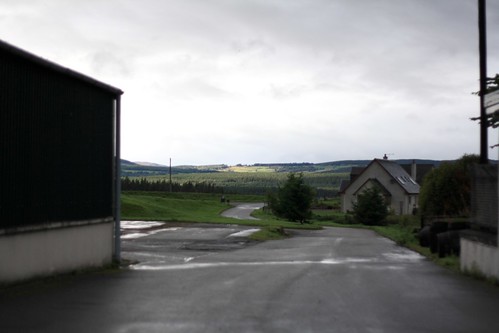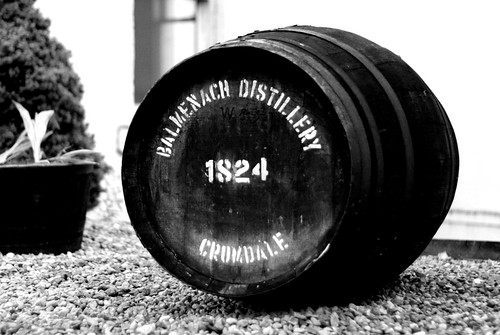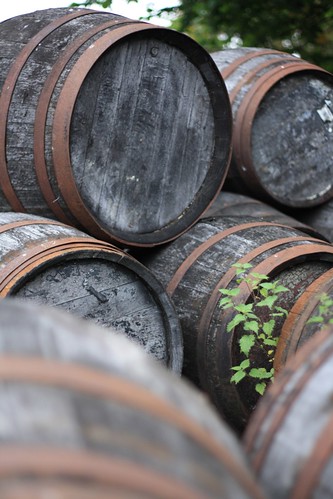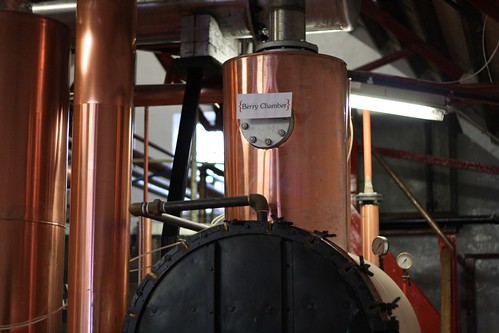Road Trip: Balmenach Distillery and Caorunn

Scotland - and it's likely that I'm not the first person to notice - has a long history of distilling. The obvious product of that history is whisky - single malt or blended - but like any country with that kind of tradition, it's not uncommon for producers to branch out into other spirits. Up and down the length of the country, you'll find vodkas, gins, liqueurs, and much more besides, all produced on scales from a single shop to multi-national distribution runs.
All of this became particularly relevant as I accompanied Andrew Kearns from Monteiths, the winner of the Edinburgh heat of Caorunn Gin's cocktail competition, to the Balmenach distillery in Speyside. We travelled up with the Glasgow party, including regional winner David Smillie from the Blythswood Square Hotel and Caorunn's brand ambassador Ervin Trykowski, and met up with 99 Bar & Kitchen's Mike McGinty and the Aberdeen contingent at the distillery.

The word Speyside should be familiar to anyone with an appreciation of single malt Scotch. Of Scotland's whisky producing regions (the others being Highland, Lowland, Islay, Islands, and Campbeltown), it's home to the greatest number of working distilleries - including those of the world's top selling single malts, the Glenlivet and Glenfiddich.

The Balmenach distillery isn't a new addition to the scene; it was established by James McGregor at some point in the early 19th Century (it's often dated to 1824, when it was officially licensed but it's a fair guess that they'd been producing before then). It remained in family ownership through 1922 before changing hands a number of times through the 20th Century, until it's then-owner, Diageo, opted to mothball the site in 1993. Balmenach was taken over by Inver House in 1997 and production started anew in 1998.

Scotch whisky is, as many spirits are these days, subject to a whole raft of legislation governing what may and may not be used in its production, the method of production, length of maturation, and so on. As far as ageing goes, in order to qualify as a Scotch whisky, it must be barrel aged in Scotland for a minimum of three years and one day. If you wanted to bring a single malt to market, you'd be up against a lot of 10 and 12 year old expressions, so you're looking at a decade before you can bottle something and that's before you consider that the age statement on a bottle of Scotch refers to the youngest whisky in the blend (even for single malt). If you want to compete, then it could be upwards of fifteen years before you have the stock on hand to blend a whisky that you could label as a 10 year old.

Ageing whisky is not a cheap process, and so it makes a lot of sense to use the equipment you've got to make something that you can bring to market a lot sooner than, say, fifteen to twenty years and that means white spirits. In the case of Caorunn, the equipment goes some distance to shaping the product; they found two berry chamber stills -they would have typically been used in the production of perfumes.

Essentially, high-strength spirit is pumped into a vaporiser and turned into vapour. That vapour is channeled into the base of the berry chamber and passes upwards through five perforated drawers which contain a loose mixture of the eleven botanicals. Simon Buley, Caorunn's creator, says that the process differs from that used by other gin producers in that all of the vapour comes into contact with all of the botanicals; there's no other way out of the chamber.

The final product sits somewhere between a traditional style gin and newer, more exotically flavoured efforts. There are six traditional botanicals - juniper, lemon peel, orange peel, coriander seed, angelica, and quassia bark - and five Celtic ones - rowan berry (Caorunn is the Gaelic word for rowan), heather, bog myrtle (also famed as a midge repellent), dandelion, and Coul Blush apple (a local variant bred to survive in the changeable climate of Northern Scotland). It's an interesting product to work with, and we headed back to Grantown-on-Spey to see that demonstrated by the three regional finalists later in the evening. The winner was Mike McGinty from 99 Bar & Kitchen in Aberdeen, with drinks called the Haughs of Cromdale and the Celtic Fizz.

The Haughs of Cromdale
37.5ml Caorunn Gin 12.5ml Costacalda Passito Bianco (sweet dessert wine) 10ml Calvados 20ml lemon juice 15ml homemade apple gomme muddled pink lady apples smoked heather bud in boston shaker
Using a lighter, set a sprig of heather on fire. Hold the tin from a Boston shaker over the sprig to capture the smoke. Muddle the apple in the other part of the shaker and add the other ingredients along with cubed ice. Cap with the smoke-filled shaker and shake. Fine-strain into a chilled red wine glass.
Garnish with a slice of apple and a sprig of heather.
Celtic Fizz
50ml Caorunn 20ml lemon juice 20ml pressed apple juice 15ml homemade spiced apple gimme 1 dash egg white topped with Brewdog Punk IPA
Shake the first five ingredients with ice and strain into a chilled highball glass (straight up). Top with IPA.
Garnish with a single star anise.
Thanks to everyone at Caorunn and 3rdparty for making the trip happen!